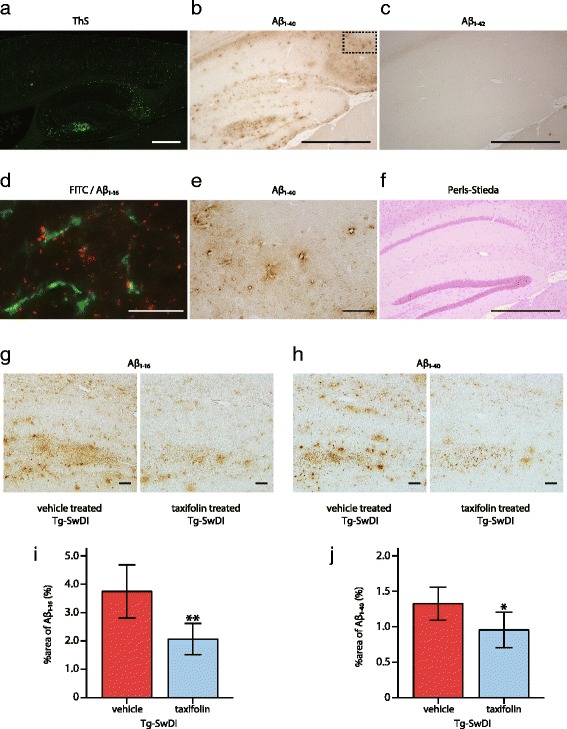Fig. 5.

Effects of taxifolin treatment on amyloid-β pathology in Tg-SwDI mice. Vehicle-treated homozygote Tg-SwDI mice exhibited cerebrovascular amyloid-β accumulation, which was most abundantly observed in the hippocampus with predominance of amyloid-β1-40, rather than amyloid-β1-42, without apparent microhemorrhages or infarcts. Amyloid-β deposits were decreased in taxifolin-treated Tg-SwDI mice compared to vehicle-treated Tg-SwDI mice. a Representative image of thioflavin-S staining. Lower magnification of the cortex and the hippocampus in the 12-month-old vehicle-treated Tg-SwDI mice. (b, c, e) Representative images of amyloid-β1-40 and amyloid-β1-42 immunostaining in the hippocampus in 8-month-old vehicle-treated Tg-SwDI mice. b Lower magnification image of amyloid-β1-40 immunostaining. c Amyloid-β1-42 immunostaining. e Higher magnification of amyloid-β1-40 accumulating vessels (corresponding to dashed square in panel b). d Representative microscopic fluorescent images of amyloid-β1-16 immunostaining (red) in the hippocampus of the 12-month-old Tg-SwDI mice after FITC dextran (green) injection. Almost all of the amyloid-β1-16 accumulation is adjacent to cerebral small vessels. f Representative images of Perls-Stieda’s iron staining in the 8-month-old vehicle-treated Tg-SwDI mice. (g and h) Representative images of amyloid-β1-16 (g) and amyloid-β1-40 (h) in the hippocampus of 8-month-old Tg-SwDI mice treated with vehicle (left) or taxifolin (right) for 7 months. (i and j) Histograms showing the density of regions immunoreactive for amyloid-β1-16 (i) and amyloid-β1-40 (j) in the hippocampus of 8-month-old Tg-SwDI mice treated with vehicle or taxifolin (n = 5 each). Scale bars indicate 500 μm (a, b, c, f), and 50 μm (d, e, g, h). Error bars indicate ± SD. *p < 0.05 and **p < 0.01
